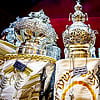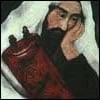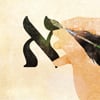The Mishnah
As explained in Chapter 1, G‑d gave the Torah to the Jewish people in two parts.
The Written Law — Torah Shebichtav.
The Oral Law — the explanation of all 613 mitzvot in the Written Law — Torah Shebaal Peh.
Before Moses died, he passed the Oral Law on to Joshua. Joshua then passed it on to the leader of the generation after him and so on. The Oral Law was never written down — it was always memorized by each generation right up until Roman times.
Under Roman rule, the Jews were persecuted and the leader of the Jews, a man called Rabbi Yehuda Hanassi — Judah the Prince, saw that if he did not write down the Oral Law, it would be forgotten. Subsequently, he wrote down the entire Oral Law and called this book the Mishnah. The Mishnah is divided into six sections or Sedarim [orders]. They are:
1) Zeraim Agricultural Laws
2) Moed Laws of Festivals
3) Nashim Laws concerning women
4) Nezikin Laws of business and damages
5) Kadshim Laws of the Temple and sacrifices
6) Taharot Laws of Purity
The Mishnah is popularly known as Shas — Shisha Sedarim.
The Talmud
Rabbi Yehuda Hanassi wrote the Mishnah in a very concise manner. In the few hundred years after his death, a tremendous amount of discussion took place, all based on the Mishnah. The discussion was written down in a book called the Talmud. In fact, two Talmuds were made:
1) The Talmud Bavli — Babylonian Talmud, edited in Babylon by two rabbis called Ravina and Rav Ashi.
2) The Talmud Yerushalmi — The Jerusalem Talmud, written in Eretz Yisrael and edited by Rabbi Yochanan.
The Talmud is huge and it contains exploration of the Mishnah, discussion, analysis, argument, stories, etc. Even today, all rabbis still study the Talmud. Learning the Talmud at the pace of one page a day, takes seven years to finish. This is called Daf Yomi — a page a day. Many great rabbis such as Rashi [Rabbi Shlomo Yitzchaki, France] wrote commentaries on the Talmud. Rashi’s commentary on the Chumash is very famous and is based on the Talmud.
Rambam — Maimonides
As you can imagine, learning through the entire Talmud is a major task. You have to learn it for many years with great diligence. About nine hundred years ago, a great Rabbi called Rambam [Rabbi Moshe Ben Maimon — Moses Maimonides] wrote a summary of all the laws brought down in the Talmud and he called the book the Mishneh Torah. The Rambam left out much of the Talmudic discussion and only wrote the actual halachot — laws. Many Jews today throughout the world study Rambam every day. If one studies three chapters a day, one finishes the Mishneh Torah in just less than a year.
Shulchan Aruch
Based on the Talmud and its commentaries, and the Rambam, a Rabbi in the 16th century called Rabbi Yosef Karo [who lived in Tzfat, Israel] wrote what probably is the most famous of all Jewish law books, called the Shulchan Aruch. The words Shulchan Aruch mean a “laid table”. The Shulchan Aruch is a summary of all Jewish law applicable nowadays.
Everything on the table is in its correct place. Every law is easy to find in his book, which is divided into four sections;
1) Orach Chayim day-to-day laws, Shabbat,
Festivals
2) Yoreh Deiah dietary laws
3) Even Hoezer laws concerning women
4) Choshen Mishpat — business laws
Jewish Law Today
Until this very day, Jewish Law is decided by the Shulchan Aruch. When a Rabbi is asked a question, he will open a Shulchan Aruch to find the answer. If the law is not mentioned in the Shulchan Aruch, he will search in the Talmud for an answer. Students who learn Jewish Law today, sit in a Talmudic College — a Yeshivah, and study the Talmud and Shulchan Aruch.
The Golden Chain
As illustrated above, the laws that we have today in Shulchan Aruch are based upon the laws in the Rambam, which are based on the Talmud, which is based on the Mishnah, which is based on what Moses received from G‑d on Mount Sinai. The origin of all Jewish Law is from G‑d on Sinai.
Law and Custom
In addition to the numerous laws of the Torah, many customs have arisen that vary from community to community. The Hebrew word for law is Halachah or Din, and the word for custom is Minhag. Oriental Jews — Sephardim, have different customs than European Jews — Ashkenazim, although both adhere to the same laws.
Order of Learning
As soon as a child starts to speak, his father should teach him the verse:
תורה צוה לנו משה מורשה קהלת יעקב
“The Torah which Moses commanded us is the heritage of the congregation of Jacob.”
This means that the Torah that Moses commanded us is the inheritance of every Jew. Then the child should learn the Shema — שמע ישראל. Every child should learn the Aleph-Bet and at the age of five, start to learn the Chumash. Chumash is usually learned with the explanation of Rashi. At a later age, a child will learn the Mishnah, and before Bar Mitzvah, every child should know of the basic laws brought in the Shulchan Aruch.
Importance of Learning
It says in the Shema: “And you shall teach them [the laws] to your children.” Every father is obligated to teach his child Torah. A Jew without Torah learning is like a fish without water. A child should never be embarrassed to ask a question.
The Jews — A People of the Torah
It is true to say that what makes the Jewish people a nation is the Torah. Without the Torah, we have no identity. G‑d promises us great rewards if we listen to the words of the Torah and keep the mitzvot.









Start a Discussion